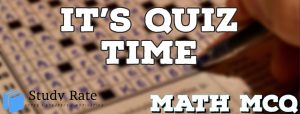We have provided you with Extra and Important Questions from Class 10 Social Science Economics Chapter 3 Money and Credit. This Extra and Important Questions will help you to score 100% in your Board Exams. These extra questions will be helpful to revise the important topics and concepts.
Join our Telegram Channel, there you will get various e-books for CBSE 2024 Boards exams for Class 9th, 10th, 11th, and 12th.
Table of Contents
Money and Credit Class 10 Important Questions with Answers Economics Chapter 3
Extra Questions for Class 10 Economics Chapter 3 Very Short Answer Type
Question: Why are transactions made in money?
Answer: A person holding money can easily exchange it for any commodity or service that he or she might want.
Question: How is money beneficial in transactions? [CBSE (F) 2017]
Answer: Money beneficial in transactions. It eliminates the need for double coincidence of wants. It acts as a medium of exchange.
Question: What is ‘double coincidence of wants’?
Answer: What a person desires to sell is exactly what the other wishes to buy.
Question: What is barter system?
Answer: When goods are directly exchanged for goods and there is no use of money, it is called barter system.
Question: Highlight the inherent problem in double coincidence of wants. [CBSE (Delhi) 2017]
Answer: The inherent problem in double coincidence of wants is that both parties have to agree to sell and buy each other’s commodities.
Question: What was used as money in early ages in India?
Answer: In the very early ages, Indians used grains and cattle as money.
Question: Which metals were used for making coins in India in later stages?
Answer: Gold, Copper, Silver coins were used in later stages for making coins in India.
Question: What does modern form of money include?
Answer: Modern form of money includes currency—that is paper notes and coins.
Question: In India, who is authorised to issue notes and currency?
Answer: In India, ‘Reserve Bank of India’ issues currency notes on behalf of the central government.
Question: What are ‘demand deposits’?
Answer: People deposit their money in the bank as it earns interest. Since the deposits in the bank accounts can be withdrawn on demand, these deposits are called demand deposits.
Question: What is a ‘cheque’? [CBSE (F) 2017]
Answer: A cheque is a paper, instructing the bank to pay a specific amount from the person’s account to the person on whose name the cheque has been issued.
Extra Questions for Class 10 Economics Chapter 3 Short Answer Type
Question: For what purposes do SHGs give loans to its members?
Answer: Small loans are provided to the members for releasing mortgaged land, for meeting working capital needs like buying seeds, fertilizers, raw materials like bamboo and cloth for housing, materials for acquiring assets like sewing machines, handloom, cattle, etc.
Question: Give an example to show that double coincidence of wants is necessary in a barter system.
Answer: A shoe manufacturer wants to sell shoes in the market and buy wheat. The shoe manufacturer will first exchange shoes that he had produced for money, and then exchange the money for wheat. Imagine how difficult it would be if the shoe manufacturer had to directly exchange shoes for wheat without using money. He would have to look for a wheat growing farmer, who not only wants to sell wheat but also wants to buy the shoes in exchange. That is, both parties have to agree to sell and buy each other’s commodities. This is known as double coincidence of wants.
Question: Why is currency accepted as a medium of exchange?
Answer: Modern forms of money include currency—paper notes and coins. Modern currency is not made of precious metals such as gold, silver and copper. The modern currency is without any use of its own. In India, Reserve Bank of India issues currency notes on behalf of the Central government. As per the Indian law, no other individual or organisation is allowed to issue currency.No individual in India can legally refuse a payment made in rupees.
Question: Why does the formal or informal sector asks for a collateral?
Answer: Every loan agreement specifies an interest rate which the borrower must pay to the lender along with the repayment of the principal. In addition, lenders may demand a collateral or an asset that the borrower owns to use it as a guarantee until he repays the loan. Interest rate, collateral and documentation requirement and the mode of repayment are the terms of credit required for formal or informal sectors for loans.
Question: How are cooperatives functioning in the rural areas to solve the problem of credit?
Answer: Besides banks, the other major source of cheap credit in rural areas are the cooperatives. Members of a cooperative, pool their resources for cooperation in certain areas.
Cooperatives form members, who accept deposits from its members. With these deposits as collateral, the cooperative obtains a large loan from the bank. These funds are used to provide loans to members. Once these loans are repaid, another round of lending can take place.
Question: Identify transactions involving money in our day-to-day life.
Answer: There are several transactions involving money in any single day. In many of these transactions, goods are being bought and sold with the use of money. It eliminates the need for double coincidence of wants.
In some of these transactions, services are being exchanged with money. For some, there might not be any actual transfer of money taking place now but a promise to pay money later.
Question: Why are transactions made in money?
Answer: A person holding money can easily exchange it for any commodity or service that he or she might want. Thus, everyone prefers to receive payments in money and then exchange the money for things that they want.
Take the case of a shoe manufacturer. He wants to sell shoe in the market and buy wheat. The shoe manufacturer will first exchange shoe that he has produced for money and then exchange the money for wheat.
Question: How do farmers get into debt trap?
Answer: Farmers usually take crop loans at the beginning of the season and repay the loan after harvest. Sometimes, the failure of the crop makes loan repayment impossible. So, the farmers have to sell a part of their land to repay the loan. Credit in such a condition pushes the borrowers into a situation from which recovery is painful and they get into the debt trap.
Question: Dhananjay is a government employee and belongs to a rich household whereas Raju is a construction worker and comes from a poor rural household. Both are in need and wish to take loan. Create a list of arguments explaining who between the two would successfully be able to arrange money from a formal source. Why? [CBSE Sample Paper 2016]
Answer: Dhananjay will be able to get loan from a formal source.
Arguments: Banks are not present everywhere in rural India. Even when they are present, getting a loan from a bank is much more difficult than taking a loan from informal sources. Bank loans require proper documents and collateral. Absence of collateral is one of the major reasons which prevents the poor from getting bank loans. Informal lenders such as moneylenders, on the other hand, know the borrowers personally and hence are often willing to give a loan without collateral.
Question: How is money transferred from one bank account to another bank account? Explain with an example. [CBSE (F) 2016]
Answer: Money Transfer from one bank account to another bank account. If a person has to make a payment to his or her friend and writes a cheque for a specific amount, this means that the person instructs his bank to pay this amount to his friend. His friend takes this cheque and deposit in his account in the bank. This said amount is transferred from one bank account to another bank account.
Question: How is the concept of Self Help Groups important for poor people? Give your view point. [CBSE (F) 2016]
Answer:
- Self Help Groups help in pooling the savings of the members, who are poor people.
- Members can get timely loans for a variety of purposes.
- They get loan at a reasonable rate of interest.
- It helps borrowers to overcome the problem of lack of collateral and documentation.
- It saves them from exploitation of the money lenders.
- This interest income becomes an extra source of income of the members
Extra Questions for Class 10 Economics Chapter 3 Long Answer Type
Question: What is credit? How can credit be both an asset as well as a debt trap.
Answer: Credit refers to an agreement in which the lender supplies the borrower with money, goods or services in return for the promise of future payment.
(i) Example of credit as an asset: During the festival season, a shoe manufacturer has received an order of making shoes in bulk, within a month’s time. To complete production, he hired some extra workers and has to purchase the raw materials. He asks the supplier to supply leather now and promises to pay him later. Then he took some advance payment from the trader. By the end of the month, he is able to deliver the order, make a good profit and repay the money he had borrowed.
(ii) Example of credit as debt trap: A farmer picks up the loan from a moneylender to meet the expenses of cultivation. But unfortunately the crop is hit by the pests and fails. So, he is unable to repay the loan and debt grows larger with interest. Next year, he picks up a fresh loan and is able to have a normal crop that year. But earnings are not enough to pay the earlier debt. So, he is caught in a debt trap. He can repay the loan, only after selling a part of the land.
In shoemaker’s case, credit plays a vital and positive role, whereas in farmer’s case credit pushes the borrower into a situation from which recovery is very painful.
Question: What are the terms of credit?
Answer: (i) Every loan agreement specifies an interest rate which the borrower must pay to the lender along with repayment of the principal.
(ii) In addition, lender may demand collateral, i.e., an asset that the borrower owns and uses this as a guarantee until the loan is repaid.
(iii) If the borrower fails to repay the loan, the lender has the right to sell the collateral to obtain payment.
(iv) Terms of credit comprise interest rate, collateral and documentation requirement, and the mode of repayment.
(v) The terms of credit vary substantially from one credit arrangement to another. They may vary depending on the nature of the lender and the borrower.
Question: Write a note on the success story of ‘Grameen Bank of Bangladesh’.
Answer: Grameen Bank of Bangladesh was founded by Prof. Muhammad Yunus (a recipient of Nobel Peace Prize for the year 2006) in year 1970. Over the last 42 years i.e., from 1976 to 2017, the operations of the bank spread to a large area of Bangladesh. The bank was started with a very small project and in year 2005, it spread across 40,000 villages with 6 million borrowers in various parts of Bangladesh. Most of the borrowers of this bank are women and belong to poor sections of society. These poor women have started ‘self-employment’ projects by taking credit from this Grameen bank. This credit has positive impact on these women as they started a gainful employment, which helped them not only to repay their loan but also to earn a good living for themselves and their family.
Question: How can the formal sector loans be made beneficial for poor farmers and workers? Suggest any five measures. [CBSE (AI) 2016]
Answer: Formal sector loans can be made beneficial for poor farmers and workers in the following ways:
- It is required to create awareness among farmers about formal sector loans.
- Process of providing loans should be made easier.
- It should be simple, fast and timely.
- More number of Nationalised banks/cooperative banks should be based in rural sector.
- Banks and cooperatives should increase facility of providing loans so that dependence on informal sources of credit reduces.
- The benefits of loans should be extended to poor farmer and small scale Industries.
- While formal sector loans need to expand, it is also necessary that everyone receives these loans.
Question: “The rich households are availing cheap credit from formal lenders whereas the poor households have to pay a heavy price for borrowing.” Comment.
Answer:
- The formal sector still meets only about half of the total credit needs of the rural people.
- The remaining credit needs are met from informal sources.
- Most loans from informal lenders carry a very high interest rate and do little to increase the income of the borrowers.
- Thus, it is necessary that banks and cooperatives increase their lending particularly in the rural areas, so that the dependence on informal sources of credit reduces.
- While formal sector loans need to expand, it is also necessary that everyone receives these loans.
- At present, it is the rich households who receive formal credit whereas the poor have to depend on the informal sources.




